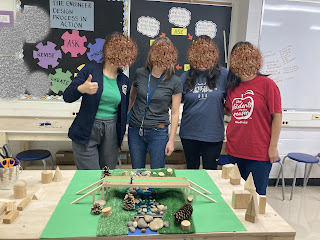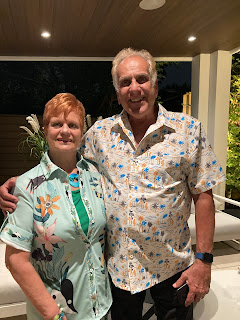I couldn't decide which topic to reflect on this week, so I thought I'd do a general reflection of the past three weeks with three focus points. (Can you believe this is the start of the fourth week of school already?)
STEM
I am teaching two classes of STEM, to both of the Grade 1-2 groups. I'm relatively pleased with how it's progressed so far. We've only had two classes, because of the way our 5-day schedule plays out.
Our first class began with an anticipation guide, to see what they knew before we began about what STEM / STEAM was all about. I read the fantastic Ashley Spires book, "The Most Magnificent Thing", and then we built with Keva Planks. Our second class officially introduced the STEM acronym and we sorted elements of the Engineering Design Process on the blackboard. Afterwards, we returned to the Keva Planks and had a much more focused challenge: How might you make the tallest possible structure only using 12 Keva Planks?

I took many pictures, to use as observational data. Some of the students used more than 12 planks. Some worked together. Some worked independently. Some used the shelves to support their structures. Some created free-standing structures. I brought out a ruler to measure the builds, and I eventually had to bring out a meter stick, because many of their constructions were taller than 30 cm. I liked looking at how they used the ruler - some just looked at the ruler as a single, non-standard unit of measurement (e.g. "my tower is the same as this ruler"), whereas others looked at the numbers but not the units (e.g. "mine is 26").
I think that this coming week, we will look at the pictures I took and comment on the various builds, to tie in with the "improve" portion of the engineer design process. I was happy to see that this activity was doable for all students, regardless of language ability.
ESL
Being the Primary-Junior ESL teacher is new to me this year. I'm still taking my ESL Part 2 AQ to learn the ropes and I attended the TDSB "New to ESL" workshop. Because many of my students are at STEP 1 or 2, I withdraw small groups for direct instruction and support. I still haven't finished my reading and writing assessments yet. I had hoped that the tasks I had planned would be semi-independent, but that's not the case.
I've been really focused on encouraging their conversational English. We played a game I modified from the Tribes TLC energizer "3 Ball Pass" to work on pronouns and for the students to get to know each other. We also worked on a simple collaborative art piece that practiced our color vocabulary: painting huge rainbows that will go on display for Curriculum Night this week. The small groups brainstormed words or phrases that we will type and post with our rainbows in different languages; one example was ["Like a rainbow,] you are ____".



I also explained an incentive program I'll be using in ESL. I do not want to discourage the use of their home languages, but I don't want them to rely purely on speaking their shared language with the other students in their ESL class. Therefore, I will be giving out tickets when I hear them speaking English or attempting to speak English during certain tasks. After two weeks, we will gather to have a lottery draw; I'll read out the numbers in English and if they have a match, they can win a prize from the prize box. For instance, while the paint was drying on our rainbows, I asked the students to help me look at photos / pictures of other students and then deliver them to the classes for the students to keep. We practiced asking each other "Who is this?" and the possible replies in English: "I don't know" or "That is XXX". We added the question "Whose class are they in?" and sorted the old photos into piles. We then decided on a way to address the teachers in the class with a rehearsed sentence ("Please give these pictures to the students who are in the photos.") Everyone made an attempt at speaking to the teacher. I have to praise my colleagues. They were so patient and encouraging. They thanked them for the delivery and often slowly asked the ESL students for their names. It was an authentic language task, made even sweeter with the potential for a tangible reward later on.
Partnering Units
You can tell I'm old - I still call collaborative planning, teaching, and assessing between the school library and the classroom(s) by the name used in the 1982 document, "Partners in Action". I am beyond excited that I get to have some collaborative teaching time in my schedule this year. If you recall, last year, I had to sacrifice all of my partner time to ensure that our MLLs received enough support from our ESL teacher, who was only allocated 0.5 in our staffing. This year, I have room in my schedule to co-teach and I am delighted. I've already launched a few collaborations.
Grade 6 Social Studies
Nelani Kokularajan is our Grade 6 teacher in the afternoon. She has already begun her social studies unit with a look at treaties. We did our planning over email and decided to use Gather in a way similar to what I did back in 2021 when I had my own class. Having two teachers for this lesson was definitely a benefit. Nelani captured the snippets of conversation we heard as the pre-teens seized land and conquered territory in a virtual world that they had just entered without instruction or direction. These are just some of the photos I took of what we saw going on. I can't wait until next week when we discuss and dissect what went on in that virtual space.
Grade 4-5 Social Studies
Our LTO in the Grade 4-5 welcomed the opportunity to collaborate, but asked if it was at all possible for her to get caught up on her diagnostic assessments. So I supplemented her current packages with some hands-on activities. I promised the Grade 4s that I would bring in the chain mail armor I own and work with them next time. This week, I pulled the Grade 5s aside and we played a game that I purchased while I was on my cruise to Alaska. This game was made by an Indigenous artist from the northwest. We had to balance salmon fry and salmon eggs on the back of the salmon. The students enjoyed the break from the pen and paper tasks. We only just began to discuss how we can determine culturally relevant themes from the game before I had to leave for another class, so I hope to continue that chat later on.
Grade 5 Science
I am happy that I'll get to work with Brenda Kim again. We did this colossal collaborative lesson with our student teachers back in 2020 that was really impressive. This time, it's just the two of us, but it still looks like it will be rewarding. We used last week to sketch out our plans and this coming week, we'll tackle Expectation E2.5 from the Grade 5 Science curriculum and examine renewable and non-renewable resources of energy. I found this cool kit I bought ages ago that helps students build a solar panel system to collect, store, and use solar energy, so I plan on using it for my portion of the lesson. I wish we had more time to iron out the details, but there's only so much time in the day.
So, things seem to be going quite well considering it's so early in the school year. Of course, many of these plans will take a brief hiatus. The photo below will give a hint why the pause is needed.
Yes, the book fair is back! Wish me luck!


















































